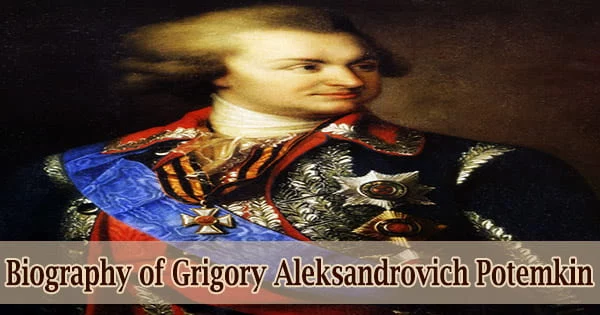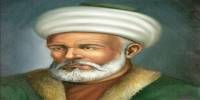Biography of Edward Teller
Edward Teller – Hungarian-American theoretical physicist.
Name: Edward Teller
Date of Birth: January 15, 1908
Place of Birth: Budapest, Austria-Hungary
Date of Death: September 9, 2003 (aged 95)
Place of Death: Stanford, California, United States
Occupation: Physicist
Father: Max Teller
Mother: Ilona
Spouse/Ex: Augusta Maria Harkany (m. 1934-2000)
Children: Paul Teller, Wendy Teller
Early Life
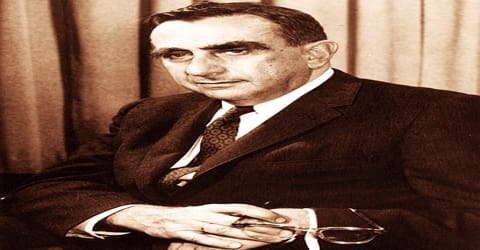
A Hungarian-born American nuclear physicist who participated in the production of the first atomic bomb (1945) and who led the development of the world’s first thermonuclear weapon, the hydrogen bomb, Edward Teller was born on January 15, 1908, in Budapest, Austria-Hungary, into a Jewish family. He is also known for his extraordinary contributions to nuclear and molecular physics, surface physics and spectroscopy (particularly the Jahn-Teller and Renner-Teller effects).
Teller’s extension of Enrico Fermi’s theory of beta decay, in the form of Gamow-Teller transitions, provided an important stepping stone in its application, while the Jahn-Teller effect and the Brunauer–Emmett-Teller (BET) theory have retained their original formulation and are still mainstays in physics and chemistry. Teller also made contributions to Thomas-Fermi theory, the precursor of density functional theory, a standard modern tool in the quantum mechanical treatment of complex molecules. In 1953, along with Nicholas Metropolis, Arianna Rosenbluth, Marshall Rosenbluth, and Augusta Teller, Teller co-authored a paper that is a standard starting point for the applications of the Monte Carlo method to statistical mechanics. Throughout his life, Teller was known both for his scientific ability and for his difficult interpersonal relations and volatile personality.
Hailed as the ‘the father of the hydrogen bomb’, Teller was one of the most imaginative and creative physicists. He holds a significant position in the development of nuclear energy and has made a major contribution in the fields of nuclear physics, molecular physics, and spectroscopy. This weapons research pioneer, whose work on nuclear science was of crucial importance, played a key role in the American War effort. He advocated nuclear energy development, proposed the need for a strong nuclear arsenal and the need for a vigorous nuclear testing program in the country. He also helped to create nuclear reactor safety standards. He also investigated and proposed non-military uses of nuclear explosives and also advised Israel on nuclear matters.
In his later years, Teller became especially known for his advocacy of controversial technological solutions to both military and civilian problems, including a plan to excavate an artificial harbor in Alaska using thermonuclear explosive in what was called Project Chariot. He was a vigorous advocate of Ronald Reagan’s Strategic Defense Initiative.
Childhood, Family and Educational Life

Edward Teller, Hungarian Ede Teller was born on January 15, 1908, in Budapest, Hungary to Jewish parents, Max Teller, who was an attorney and Ilona Teller, a pianist. Teller left Hungary in 1926 and moved to Germany. As a student in Munich, he lost his right foot under a moving streetcar requiring him to wear a prosthetic foot and leaving him with a life-long limp.
In 1928, Teller graduated from the University of Karlsruhe with a BS degree in Chemical Engineering. He graduated in chemical engineering at the University of Karlsruhe and received in 1930 his Ph.D. in physics under Werner Heisenberg at the University of Leipzig. Teller’s dissertation dealt with one of the first accurate quantum mechanical treatments of the hydrogen molecular ion.
In 1930 Teller befriended Russian physicists, George Gamow, and Lev Landau. Teller’s lifelong friendship with a Czech physicist, George Placzek, was also very important for his scientific and philosophical development. It was Placzek who arranged a summer stay in Rome with Enrico Fermi in 1932, thus orienting Teller’s scientific career in nuclear physics. In 1930, Teller moved to the University of Göttingen, then one of the world’s great centers of physics due to the presence of Max Born and James Franck, but after Adolf Hitler became Chancellor of Germany in January 1933, Germany became unsafe for Jewish people, and he left through the aid of the International Rescue Committee. He went briefly to England and moved for a year to Copenhagen, where he worked under Niels Bohr. He returned to England in September 1934.
In 1935, Teller moved to the United States of America and worked as physics Professor at the George Washington University, where he taught until 1941.
Personal Life
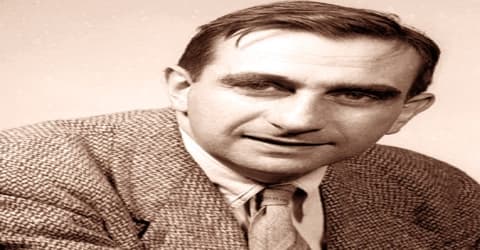
When Edward Teller was a young student, he met with a car accident, which caused a severe injury on his right foot. The accident resulted in a prosthetic foot and he had a lifelong limp.
In February 1934, Teller married his long-time girlfriend Augusta Maria “Mici” (pronounced “Mitzi”) Harkanyi, the sister of a friend.
This acclaimed scientist used to play the piano late in the night, a practice that would frustrate and annoy his neighbors. Teller was the inspiration behind the 1964 film ‘Dr. Strangelove or: How I Learned to Stop Worrying and Love the Bomb’.
Career and Works
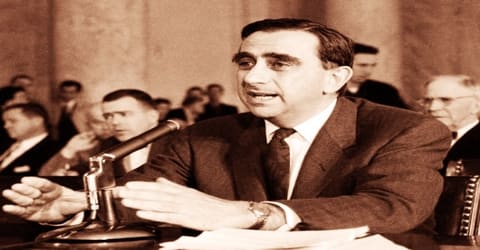
In 1935 Edward Teller and his bride, Augusta Harkanyi, went to the United States, where he taught at George Washington University in Washington, D.C. Together with his colleague George Gamow, he established new rules for classifying the ways subatomic particles can escape the nucleus during radioactive decay. Following Bohr’s stunning report on the fission of the uranium atom in 1939 and inspired by the words of Pres. Franklin D. Roosevelt, who had called for scientists to act to defend the United States against Nazism, Teller resolved to devote his energies to developing nuclear weapons.
When World War II began, Teller wanted to contribute to the war effort. On the advice of the well-known Caltech aerodynamicist and fellow Hungarian émigré Theodore von Kármán, Teller collaborated with his friend Hans Bethe in developing a theory of shock-wave propagation. In later years, their explanation of the behavior of the gas behind such a wave proved valuable to scientists who were studying missile re-entry.
In 1941, Teller became a citizen of the United States of America, before which he worked as a theoretical physicist. However, after he earned U.S. citizenship, he became interested in the study of nuclear energy. He joined Enrico Fermi’s team at the University of Chicago in the epochal experiment to produce the first self-sustaining nuclear chain reaction. Teller then accepted an invitation from the University of California, Berkeley, to work on theoretical studies on the atomic bomb with J. Robert Oppenheimer; and when Oppenheimer set up the secret Los Alamos Scientific Laboratory in New Mexico in 1943, Teller was among the first men recruited.
In 1942, Teller was invited to be a part of a seminar on the Manhattan Project, a project that developed the first atomic bomb. During the session, he gave ideas about producing a fission weapon. At war’s end Teller wanted the U.S. government’s nuclear weapons development priorities shifted to the hydrogen bomb. Hiroshima, however, had had a profound effect on Oppenheimer and other Manhattan Project scientists, and few had the desire to continue in nuclear weapons research.
In early 1943, the Los Alamos laboratory was established in Los Alamos, New Mexico to design an atomic bomb, with Oppenheimer as its director. Teller moved there in March 1943. Apparently, Teller managed to annoy his neighbors thereby playing the piano late in the night. Teller became part of the Theoretical (T) Division. He was given a secret identity of Ed Tilden. He was irked at being passed over as its head; the job was instead given to Hans Bethe. Oppenheimer had him investigate unusual approaches to building fission weapons, such as autocatalysis, in which the efficiency of the bomb would increase as the nuclear chain reaction progressed, but proved to be impractical. He also investigated using uranium hydride instead of uranium metal, but its efficiency turned out to be “negligible or less”. He continued to push his ideas for a fusion weapon even though it had been put on a low priority during the war (as the creation of a fission weapon proved to be difficult enough). On a visit to New York, he asked Maria Goeppert-Mayer to carry out calculations on the Super for him. She confirmed Teller’s own results: the Super was not going to work.
In 1946, Teller participated in a conference on hydrogen bomb design and the same year he quit his job at the Los Alamos Laboratory and began to work as a Professor at the University of Chicago. At the end of the conference, in spite of opposition by some members such as Robert Serber, Teller submitted an optimistic report in which he said that a hydrogen bomb was feasible and that further work should be encouraged on its development. Fuchs also participated in this conference and transmitted this information to Moscow. With John von Neumann, he contributed an idea of using implosion to ignite the Super. The model of Teller’s “classical Super” was so uncertain that Oppenheimer would later say that he wished the Russians were building their own hydrogen bomb based on that design so that it would almost certainly retard their progress on it.
The Soviet Union’s explosion of an atomic bomb in 1949 made him more determined that the United States has a hydrogen bomb, but the Atomic Energy Commission’s general advisory committee, which was headed by Oppenheimer, voted against a crash program to develop one. The debate was settled by the confession of the British atomic scientist Klaus Fuchs that he had been spying for the Soviet Union since 1942. Fuchs had known of the American interest in a hydrogen bomb and had passed along early American data on it to the Soviets. In response, Pres. Harry Truman ordered the go-ahead on the weapon, and Teller labored on at Los Alamos to make it a reality.
On November 1, 1952, the ‘Ivy Mike’, the thermonuclear weapon created by him and Stanislaw Ulam was successfully tested at the test site, Enewetak. After the testing, Teller became known in the press as ‘the father of the hydrogen bomb’. From 1958 to 1960 he was the Director of the Lawrence Livermore National Laboratory, which he co-founded along with American physicist Ernest Lawrence. For almost the next four decades it was the United States’ chief factory for making thermonuclear weapons. Teller was associate director of Livermore from 1954 to 1958 and from 1960 to 1975, and he was its director in 1958-60. Concurrently he was a professor of physics at the University of California, Berkeley, from 1953 to 1960 and was professor-at-large there until 1970.
Teller was a recipient of the Enrico Fermi Award, Albert Einstein Award, the National Medal of Science and the Harvey Prize from the Technion-Israel Institute. He was an active campaigner for civil defense from the 1950s. Teller also worked as a senior research fellow at the Hoover Institute, where he studied the international and national policies of energy and defense. A few of the notable books he has written include “Conversations on the Dark Secrets of Physics Better a Shield Than a Sword”, “Pursuit of Simplicity” and “Energy from Heaven and Earth”.
Teller opposed the 1963 Nuclear Test Ban Treaty, which banned nuclear weapons testing in the atmosphere, and he was a champion of Project Plowshare, an unsuccessful federal government program to find peaceful uses for atomic explosives. In 1975, Teller retired as a Professor of Physics at the University of California, Berkeley, after which he became the Director Emeritus of the Livermore Laboratory. In the 1970s Teller remained a prominent government adviser on nuclear weapons policy, and in 1982-83 he was a major influence in Pres. Ronald Reagan’s proposal of the Strategic Defense Initiative, an attempt to create a defense system against nuclear attacks by the Soviet Union.
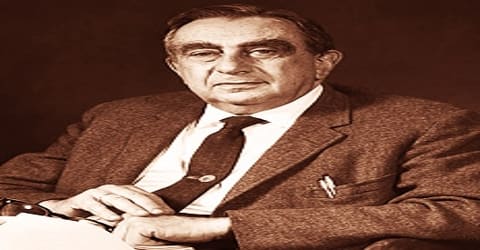
In 1987 Teller published a book supporting civil defense and active protection systems such as SDI which was titled Better a Shield than a Sword and his views on the role of lasers in SDI were published, and are available, in two 1986-7 laser conference proceedings. His final paper, published posthumously, advocated the construction of a prototype liquid fluoride thorium reactor. The genesis and impetus for this last paper was recounted by the co-author Ralph Moir in 2007.
Awards and Honor
In 1962, Edward Teller was the recipient of the Enrico Fermi Award that is awarded for pursuit in energy science and technology.
In 1986, Teller was awarded the United States Military Academy’s Sylvanus Thayer Award.
In 1991, Edward Teller was awarded the Ig Nobel Prize Peace for his ‘lifelong efforts to change the meaning of peace as we know it’.
In 2003, Teller was awarded the Presidential Medal of Freedom, which was awarded to him by the then President George W. Bush.
Death and Legacy
Edward Teller died in Stanford, California on September 9, 2003, at the age of 95. He had suffered a stroke two days before and had long been suffering from a number of conditions related to his advanced age. A wish for his 100th birthday, made around the time of his 90th, was for Lawrence Livermore’s scientists to give him “excellent predictions-calculations and experiments-about the interiors of the planets”.
Teller invented the ‘Teller-Ulam design’, which was the first workable design of a hydrogen bomb. This design was used to create the ‘Ivy Mike’, the thermonuclear weapon that was successfully tested in 1952.
In his early career, Teller made contributions to nuclear and molecular physics, spectroscopy (the Jahn-Teller and Renner-Teller effects), and surface physics. His extension of Fermi’s theory of beta decay (in the form of the so-called Gamow-Teller transitions) provided an important stepping stone in the applications of this theory. The Jahn-Teller effect and the BET theory have retained their original formulation and are still mainstays in physics and chemistry. Teller also made contributions to Thomas-Fermi theory, the precursor of density functional theory, a standard modern tool in the quantum mechanical treatment of complex molecules.
In 1981, Teller became a founding member of the World Cultural Council. He was elected a member of the U.S. National Academy of Sciences in 1948. He was a fellow of the American Academy of Arts and Sciences, the American Association for the Advancement of Science, and the American Nuclear Society. Teller was also named as part of the group of “U.S. Scientists” who were Time magazine’s People of the Year in 1960, and an asteroid, 5006 Teller, is named after him.
Information Source:



